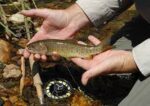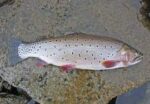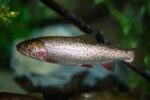This post was last updated on August 28th, 2021 at 12:28 pm
The Bonneville Cutthroat Trout is a sub species of cutthroat trout native to much of Utah, parts of southern Idaho and Nevada. This species evolved in what was Lake Bonneville in Utah, this lake essentially dried up and merged with great salt lake. This left the Cutthroat species to fend for themselves in the isolated rivers and streams surrounding great salt lake. Great salt lake is too salty to support any species of fish, but many tributaries around it have high populations.
Bonneville Cutthroat Trout Facts & Information

The Bonneville Cutthroat trout is not known to be a wary species of fish. It will eagerly accept a fly or lure, even if it is not presented to the fish perfectly. This species is fairly easy to differentiate from most other cutthroat species by its large loosely scattered spots. It is also much more subdued in coloration compared to many other subspecies.
Bonneville Trout History
The Bonneville trout, just like many species of cutthroat trout has suffered hardship at the hand of man. Due to extreme fishing pressure, over harvesting, logging and many other factors, pure strains of the trout were once thought to be extinct . This trout still has a lot of factors that could ultimately be its demise. In many areas of the bonneville cutthroat there is a significant amount of planting of non native fish. This leaves this trout vulnerable to predation, hybridization, and competing with fish that were not in its environment as it evolved. The Bonneville Cutthroat trout is now the State fish of Utah as of 1997. It replaced the rainbow trout because of its importance as a food source to the Mormon pioneers, but it was also a major food source for the American Indians.
A 1864 historical account states that in one haul of a commercial sized net, between 3,500 and 3,700 pounds of cutthroats were caught. This mass quantity of fish led to the over fishing and harvesting of this species. In the late 1800’s other trout species were being planted in the area. The Brook trout, brown trout and rainbow trout took up all the space left over from over harvesting of the cutthroat. Sadly the Bonneville is just one example of a trout species hanging on for dear life. Many of the cutthroat species are in the endangered species status.
What do Bonneville Cutthroat Trout eat?
Bonneville Cutthroat trout typically feed downstream of riffles where aquatic invertebrates are thriving. Like many trout species, Bonneville cutthroat trout are opportunistic feeders and mostly consume invertebrates, small fish, and zooplankton.
Where do the Bonneville Cutthroat Trout live?
The Bonneville trout is native to much of Utah, parts of southern Idaho and Nevada. This species evolved in what was Lake Bonneville in Utah, this lake essentially dried up and merged with great salt lake.



